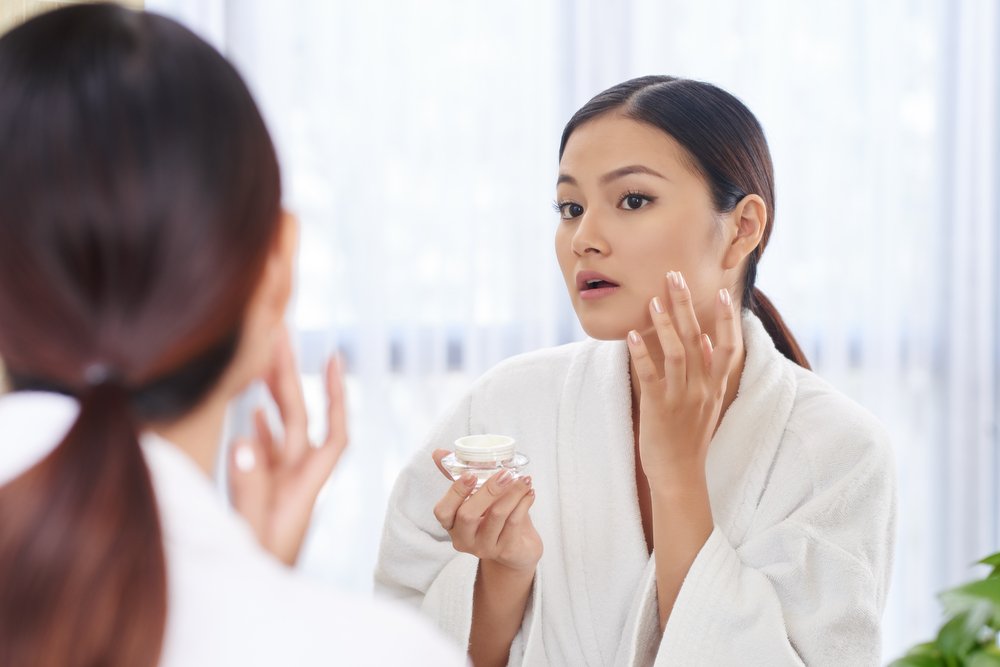Your skin is the largest organ in your body and performs some of its most important functions. While most people know they should keep their skin clean and healthy through regular washing and showers, many don’t realize that skin care routines are not one-size-fits-all. There are, in fact, four unique types of skin, all of which require distinct skin care regimens for optimal healthiness. To take the first step toward more beautiful skin, find out what type of skin you have and plan out a personalized skin care routine that can effectively target the areas of your face that need the most attention.
Oily Skin
It happens to many people: They wash their face in the morning before work, and their skin feels greasy and uncomfortable before noon. If you find your skin has a constant “dewy” appearance, you may have oily skin. People with an oily skin type often have enlarged pores and suffer more acne or blemishes due to their increased oil production.
Achieving blemish-free, glowing skin can often be difficult for those with oily skin, as the excess oil (or sebum) can clog pores and trap dirt, makeup or other debris. Hormonal imbalance, stress, and humidity may also be making your oily skin worse.
People with oily skin will need a gentle skin care routine to combat sebum production and heal blemishes. Shop around for noncomedogenic skin cleansers and cosmetics. These products aren’t heavy and won’t clog your pores. It may take some time to find a product you like, especially if you have sensitive skin as well. Once you’ve found a great cleanser, be sure to use it twice daily to remove as much sebum as possible. Remember to be gentle. Scrubbing can harm the top layers of skin and actually stimulate sebum production. With diligent use of a gentle cleanser twice a day, your skin should feel less greasy and look more vibrant. As with any skin type, do not pick or pop pimples, as it will damage the skin and cause scarring.
Dry Skin
On the other end of the spectrum from oily skin is dry skin. People with this skin type suffer from a lack of necessary hydration and too little sebum production. Without proper moisture, dry skin can look thin, wrinkled or rough. A lack of an oil barrier allows water to evaporate from the surface of the skin freely and leaves the skin vulnerable to the elements, including wind and sunshine.
If your skin is itchy, rough, scaly, patchy, tight or has lost elasticity, you may have dry skin. Age, element exposure, drying ingredients in cosmetics and bath products, medications, hormonal changes, and genetics may be to blame for dry skin.
Caring for dry skin requires additional moisturizing products that can protect what little moisture your skin does have. Try limiting the length of your hot showers or baths and apply moisturizer immediately afterward to create a barrier that traps moisture in your skin. While bathing, gentle soaps, and shampoos will sap less water from your skin than harsher cleansers. If you find moisturizing frequently isn’t quite enough to help you maintain moisture, a humidifier in your home may soften and moisturize your skin.
Normal Skin
While “normal” is a highly subjective word to many people, dermatology defines normal skin types as those with a good balance of oil and dryness. People with normal skin may have small pores, a healthy glow, soft and supple skin texture and few to no blemishes. While some people with normal skin suffer from sensitivity, it isn’t common to the skin type.
Normal skin doesn’t present large, glaring issues, so those with this skin type can customize their routine depending on their personal appearance goals. It is wise, however, to apply all the care basics for each type of skin to maintain a pristine appearance. A gentle cleanser is a must-have and scrubbing or long, hot showers should be avoided to prevent drying and excess oil production. It’s always a good idea to opt for noncomedogenic products as well to prevent blemishes.
Combination Skin
If you’re scratching your head at this point wondering why your cheeks are dry but your forehead is oily, you can rest assured that there is a skin type for you as well. Combination skin types are exactly what they sound like. They combine aspects from other skin types. This variation typically occurs on the cheeks or in your “T-zone,” the sections straight down the center of your face and across the forehead that make a “T” shape. People with combination skin can display any of the above symptoms, but most often have an oily forehead, enlarged pores, and normal or dried out cheeks.
Caring for your combination skin requires a more targeted approach to skin care. Moisturizer should be applied to the driest areas of your face, for example, while facial cleanser should be used more often on your most oily areas. However, people with combination skin should follow all the basics of skin care, just like normal skin. Cut down on harsh soaps and hot showers and moisturize right when you get out of the shower.
Revitalize Your Beauty Career With Houston Training Schools
The skin is a complex and fascinating organ that often dictates the first impression we make when meeting others. If you love skin care and want to help other people achieve their beauty goals, a career in esthetics may be for you. Find out how you can transform your career with a certificate from Houston Training Schools today! Our small, hands-on classes and experienced instructors will ensure you have the knowledge to best serve your clients during every step of your career. Contact us online or call 877-640-4747 to learn more about our esthetics program or any of our four fantastic campuses in the Houston area.


